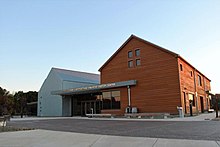Harriet Tubman Underground Railroad Visitor Center
 |
|
| Established | March 10, 2017 |
|---|---|
| Location | 4068 Golden Hill Road, Church Creek, Maryland, U.S. |
| Coordinates | 38°26′37″N 76°08′41″W / 38.443695°N 76.144747°WCoordinates: 38°26′37″N 76°08′41″W / 38.443695°N 76.144747°W |
| Type | History museum |
| Director | Dana Paterra, Maryland Park Service |
| Architect | GWWO, Inc., Architects |
| Owner | National Park Service and the State of Maryland |
| Website | www |
The Harriet Tubman Underground Railroad Visitor Center is a visitors' center and history museum located on the grounds of the Harriet Tubman Underground Railroad State Park (a Maryland state park) in Church Creek, Maryland, in the United States. The state park is surrounded by the Blackwater National Wildlife Refuge, whose north side is bordered by the Harriet Tubman Underground Railroad National Historical Park. Jointly created and managed by the National Park Service and Maryland Park Service, the visitor center opened on March 10, 2017.
Harriet Tubman was born Araminta Ross in the early 1820s on the plantation of Anthony Thompson near the village of Madison in Dorchester County on Maryland's Eastern Shore. A year or two after she was born, Edward Brodess claimed Tubman, her mother, and her four siblings as an inheritance and took them away to his farm near Bucktown, about 10 miles (16 km) to the east. After Brodess died in 1849, Tubman was at risk of being sold. Instead, she fled slavery and moved to Pennsylvania, a state where slavery was outlawed. Over roughly the next decade, Tubman gained national fame by returning to Maryland repeatedly to lead her siblings and other slaves to freedom via what is now called the Underground Railroad.
The entire area remained in private hands until 1933, when the 28,000-acre (110 km2) Blackwater National Wildlife Refuge was established. This protected area encompassed much of the shoreline of the Blackwater River, but did not protect areas such as the Thompson farm, Brodess farm, or other areas important to Tubman's life and the history of the Underground Railroad.
...
Wikipedia
